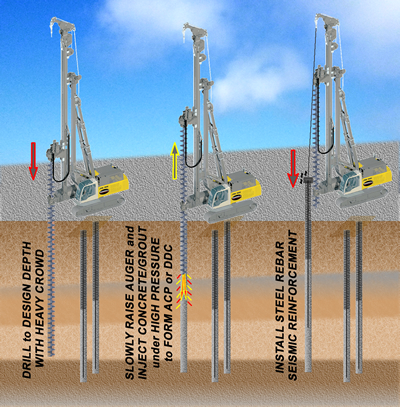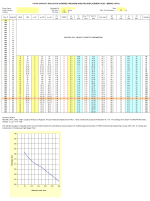Static Capacity Auger Pressure Grouted Displacement Piles
Description
Augered, pressure-injected displacement (APID) piles develop significantly higher capacities than conventional augercast (APG) piles in loose to medium dense, granular materials. During APID installation, a Ko to Kp environment is created in the materials surrounding the pile immediately prior to casting, and this condition results in increased shaft resistance in soils where displacement leads to densification. Current augercast design methodologies assume a Ko to Ka condition in the vicinity of the pile, and thus the body of knowledge associated with conventional APG piles would be expected to be a conservative base line from which to begin assessing the capacity APID pile systems.
Calculation Reference
Augered, pressure-injected displacement (APID) piles
Augercast (APG) piles
Pile Design
Auger pressure grouted displacement piles, also known as augercast or continuous flight auger (CFA) piles, are a type of deep foundation system commonly used to support structures subjected to axial and lateral loads. These piles are installed by drilling into the ground using a hollow-stemmed continuous flight auger, and then grouting the hole while the auger is slowly withdrawn. This process displaces the soil and forms a column of grout that hardens to create the pile.
To determine the static capacity of auger pressure grouted displacement piles, consider the following steps:
-
Gather necessary information: Collect site-specific information, such as soil properties, groundwater conditions, structural loads, and applicable design standards.
-
Conduct a site investigation: Perform a geotechnical investigation to determine the depth and properties of the various soil layers at the site.
-
Define pile geometry: Establish the diameter and length of the auger pressure grouted displacement pile based on the site requirements and constraints.
-
Determine the axial capacity: Calculate the axial capacity of the pile by considering the end-bearing capacity at the pile base (Qb) and the skin friction along the pile shaft (Qs). The end-bearing capacity can be calculated using bearing capacity theory, and the skin friction can be calculated using empirical correlations or soil-pile interface shear strength parameters. These calculations should consider the site-specific soil properties and the effects of the grouting process on the soil-pile interface.
-
Determine the lateral capacity: Analyze the lateral capacity of the pile using methods such as the p-y method or finite element analysis, considering the properties of the soil layers and the stiffness and length of the pile.
-
Check for buckling and structural capacity: Assess the structural capacity of the auger pressure grouted displacement pile to resist the axial loads, bending moments, and shear forces induced by the structural loads. Ensure that the pile's structural capacity is adequate and that the pile is not susceptible to buckling under the applied loads.
-
Check for global stability: Analyze the global stability of the pile foundation system, considering the potential for deep-seated slope failures or other modes of instability.
-
Prepare design drawings and specifications: Develop detailed design drawings and specifications that include the pile geometry, reinforcement layout (if applicable), and construction requirements.
It is essential to consult with experienced geotechnical and structural engineers to ensure a safe and efficient design of auger pressure grouted displacement piles, as the actual behavior and capacity of these piles can be influenced by various factors, such as soil properties, construction techniques, and quality control.
Calculation Preview
Full download access to any calculation is available to users with a paid or awarded subscription (XLC Pro).
Subscriptions are free to contributors to the site, alternatively they can be purchased.
Click here for information on subscriptions.


